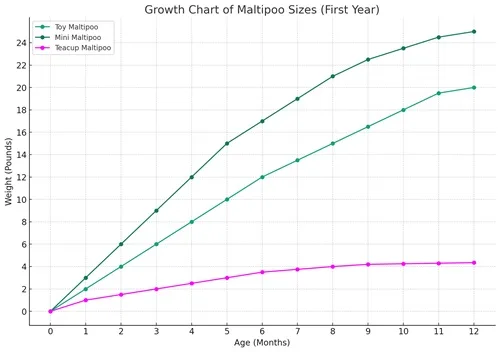Are you wondering just how big does a Maltipoo get? Well, you’re not alone. Many Maltipoo owners and potential owners find themselves curious about the full-grown size of an adult Maltipoo. Especially since Maltipoos have a fairly large range in actual sizes considering it is a small dog.
Join us as we take a look at:
- Origins of the Maltipoo
- Maltipoo sizes (did you know you can find them in three sizes),
- Growth Phases of a Maltipoo
- When Do Maltipoos Stop Growing
- How to Estimate the Full-grown size of your puppy
- Factors Affecting Maltipoo Growth and Size
- Common Misconceptions

Quick Maltipoo Size Chart
| Size Category | Weight (pounds) | Height (inches) |
| Toy Maltipoo | 5-15 | 8-12 |
| Mini Maltipoo | 15-25 | 11-14 |
| Teacup Maltipoo | <5 | <8 |
Origins of the Maltipoo
The Maltipoo, is considered to be a designer breed, a term often used for deliberately crossbred dogs. As a hybrid breed, Maltipoos are the offspring of a Maltese and a Poodle. Generally, either a Miniature Poodle, Toy Poodle or Teacup Poodle is used in the breeding.
The hybrid nature of the Maltipoo means that their appearance can vary significantly even within the same litter, as they can inherit different traits from each of their parent breeds. This is most evident in their large size variations. Even though they are generally considered one of the small dog breeds, Maltipoos can fall into the mini, toy or teacup size range.
Since the Maltipoo is not recognized by the American Kennel Club they do not have a breed standard. Breed standards are used as guidelines for a desired size, coat, and temperament.
Maltipoos became popular due to their combination of desirable traits from both the Maltese and the Poodle breeds. They are typically friendly and with an affectionate nature. They thrive on human interaction and form strong bonds with their owners making them great companions.

How Big Does A Maltipoo Get?
Maltipoo Size Options
Maltipoos come in different sizes, influenced by the size of their Poodle parent. Generally, they are categorized into three main types: toy, mini, and teacup.
Miniature Maltipoo – results from breeding a Miniature Poodle with a Maltese. These dogs usually weigh between 15 to 25 pounds and can reach a height of up to 14 inches. Mini Maltipoos inherit a friendly and playful temperament. They are adaptable, fitting well into various family environments.
Toy Maltipoo – are bred from a Toy Poodle and a Maltese. They typically weigh between 5 to 15 pounds and stand about 8 to 12 inches tall. Toy Maltipoos are known for being affectionate and lively, making them great family pets. They are small enough to be comfortable in an apartment yet sturdy enough for playing with older children.
Teacup Maltipoo – are the smallest, often weighing less than 5 pounds and standing no taller than 8 inches. They are bred to be tiny, which can sometimes involve breeding smaller-than-average Poodles and Maltese. While they are appealing due to their size, they can have more health concerns, including fragility and vulnerability to injuries. Their temperament is similar to the other sizes—affectionate and companionable—but they may require more delicate handling and protection.

Growth Phases of a Maltipoo
Maltipoos grow most rapidly in the initial months after birth, with the rate of growth tapering off as they approach adulthood. This early phase is crucial for physical and cognitive development, setting the foundation for their health and behavior as adult dogs.
Maltipoos, regardless of their size category, go through distinct growth phases, each with its unique characteristics. However, the amount of time it takes them to go through their growth trajectory largely depends on whether they fall into the toy, mini, or teacup size range.
- Toy Maltipoos experience rapid growth during their first 6 to 8 months. During this time, they quickly develop in size and personality.
- Mini Maltipoos have a similar rapid growth phase, but it might extend slightly longer, up to 10 months, as they have a bit more growing to do compared to their toy counterparts.
- Teacup Maltipoos usually have the fastest growth spurt due to their small size. Their growth can be notably quick within the first 5 to 6 months.

Here is what you can expect from each growth phase
1. Early Puppyhood (0-3 Months)
- In the first three months, Maltipoo puppies grow quickly. This is the phase where they gain weight and size most rapidly. The growth during this period is primarily physical, as they develop from tiny, vulnerable puppies into more robust and active young dogs.
- Nutrition plays a crucial role at this stage. Puppies need a diet rich in protein and essential nutrients to support their rapid development. For teacup Maltipoos, the focus should also be on preventing hypoglycemia due to their smaller size and higher metabolic rate.
2. Mid-Puppyhood (3-6 Months)
- During this phase, the growth rate begins to slow down but is still quite significant. Maltipoos continue to gain weight and grow in height, but not as explosively as in the first few months.
- This is also a critical period for socialization and early training. Their cognitive development is significant during these months, and they start to exhibit more of their individual personality and temperament.
3. Late Puppyhood (6-12 Months)
- As Maltipoos approach the end of their first year, their growth rate slows considerably. This is more noticeable in toy and mini Maltipoos. For teacup Maltipoos, they may already be close to their adult size by this stage.
- The focus during this period shifts from growth to consolidation. Puppies strengthen and refine their motor skills, their adult coat starts to come in, and they mature mentally.
During puppyhood, regular vet check-ups are essential to ensure they are on the right growth track, especially for teacup Maltipoos, who may face more health challenges.

When Do Maltipoos Stop Growing?
Mini Maltipoos usually stop growing around 10 to 12 months of age, though some may continue to fill out until they’re about 15 months old.
Toy Maltipoos usually reach their adult size by about 10 months, but some can continue to grow until they’re about 12 months old.
Teacup Maltipoos typically reach their full size faster, around 6 to 7 months.
Predicting Adult Size
Predicting a Maltipoo’s adult size often involves educated guessing and patience. Various methods exist to estimate their grown size, but it’s essential to consider the impact of genetics and health.
With these considerations in mind, let’s explore the most common approaches to estimating the adult size of your Maltipoo puppy.
- Doubling their weight at 4 months of age for Toy and Mini sizes, and 3 months for Teacup sizes, can provide a rough estimate. However, genetics and health factors can make this prediction less precise.
- Another factor is looking at the size of the parents, especially the Poodle parent, as this can give a good indication of the potential adult size. Especially if the parents are close in size.
- You can also look at past litters from the same breeding pairs to give you an idea on what to expect.

Factors Affecting Maltipoo Growth and Size
Genetic Factors
The size of a Maltipoo is influenced not only by its immediate Poodle and Maltese parents but also by the genetic traits passed down from its grandparents and great-grandparents.
This extended genetic pool can introduce variability in size. Especially in later Maltipoo generations.
For instance, if the Maltipoo’s Poodle grandparent was larger than average, or if there’s a Standard Poodle in the recent lineage, the Maltipoo might end up being larger, even if the direct Poodle parent is a Toy or Miniature. Similarly, traits from Maltese ancestors, like size and build, can also play a role.
Nutritional Factors
Nutritional factors play a crucial role in the growth and overall health of a Maltipoo. Proper nutrition impacts their growth in various ways:
- Balanced Diet: A diet that’s appropriately balanced for a growing puppy ensures that a Maltipoo grows at a healthy rate. Puppies require a diet rich in proteins, fats, vitamins, and minerals to support their rapid development. Insufficient or unbalanced nutrition can lead to stunted growth or developmental problems.
- Bone and Joint Health: Adequate levels of specific nutrients like calcium and phosphorus are vital for healthy bone development.
Maltipoo puppies should be fed high-quality dog food formulated for small breed puppies. They typically need to eat three to four times a day, maybe even more depending on their size and intake. This frequent feeding supports their high energy needs and helps in preventing hypoglycemia, especially in smaller breeds like teacup Maltipoos.
Since all puppies are different it is best to speak with your veterinarian about the frequency and daily intake of food. They can also give you recommendations on the best food brand for your puppy.
Exercise and Lifestyle Factors
Exercise and lifestyle significantly influence the growth and development of Maltipoos. Regular exercise is crucial for building strong muscles and bones, enhancing coordination and agility, and maintaining a healthy weight.
However, it’s important to balance physical activity with rest, especially for smaller or younger Maltipoos, to avoid overexertion and ensure optimal growth. Excessive exercise can lead to injuries or stress on developing bones and joints.
Growth primarily occurs during rest periods, especially in puppies. Ensuring your Maltipoo has plenty of time to rest and sleep is key for optimal growth. Puppies, in particular, need more sleep than adult dogs.
Tailoring exercise to the dog’s age and size is essential, as is providing mental stimulation and socialization through interactive play and training. This balanced approach to exercise, rest, and mental engagement is key to raising a healthy, well-adjusted Maltipoo.
Not sure if you want to get a Maltipoo? Here are 13 Reasons Why You Shouldn’t Get A Maltipoo Puppy.

Health Problems and Medical Factors
Hypoglycemia, or low blood sugar, is a condition that can affect smaller dog breeds like Maltipoos, especially the teacup and toy breeds. In Maltipoos, this condition can manifest due to their smaller body size and higher metabolic rate, which can cause their blood sugar levels to drop quickly.
The signs of hypoglycemia in Maltipoos include weakness, lethargy, confusion, trembling, and in severe cases, seizures. If not addressed promptly, hypoglycemia can lead to serious health complications and even be life-threatening.
Managing a Maltipoo’s diet is crucial in preventing hypoglycemia. Frequent, small meals throughout the day help maintain steady blood sugar levels. High-quality puppy food that’s rich in protein and complex carbohydrates is recommended to sustain energy.
Regular vet check-ups are important for monitoring a Maltipoo’s overall health and detecting any signs of hypoglycemia early. In cases where hypoglycemia is observed, a veterinarian can provide immediate care and guidance on long-term management to prevent recurrence.
For more information on Toy Breed Hypoglycemia the Animal Care Clinic has an easy to understand blog post.
Looking for a small dog but not sure which one? Check out our post on Maltipoo vs Shih Tzu Comparison: 8 Key Differences

Common Misconceptions About Maltipoo Sizes
- All Maltipoos are Very Small: While Maltipoos are generally considered a small breed, their size can vary significantly, especially depending on the size of the Poodle parent.
- Teacup Size is a Recognized Category: The term “teacup” is commonly used by breeders to describe extremely small dogs but it’s not an officially recognized size category by major kennel clubs. Teacup Maltipoos are not a separate breed; they are just smaller-sized individuals of the breed, often bred to be that small size.
- Smaller Maltipoos are Healthier: There’s a misconception that smaller Maltipoos are healthier or easier to manage. In reality, very small or teacup-sized dogs can have more health issues, including a higher risk of hypoglycemia, dental problems, and bone fractures due to their fragile size.
- Bigger Maltipoos are Less Desirable: Some believe that larger Maltipoos are less desirable or don’t possess the same breed characteristics as smaller ones. However, size does not affect a Maltipoo’s personality or suitability as a pet. Larger Maltipoos can be just as affectionate, intelligent, and loyal as their smaller counterparts.
So, How Big Does A Maltipoo Get?
We hope our guide has provided insights into the various sizes these adorable dogs can grow into, helping you to understand how genetics, nutrition, and overall proper care influence their growth from playful puppies to full-grown companions.
